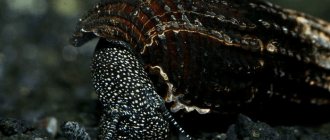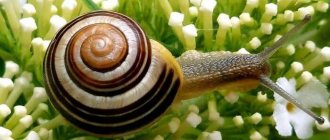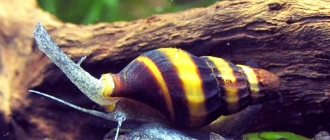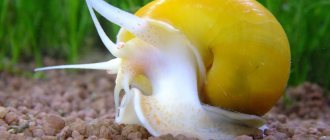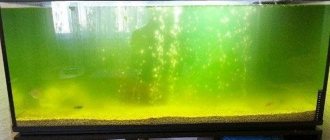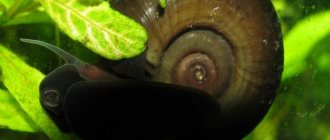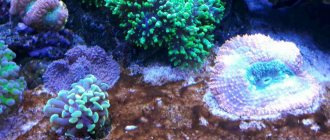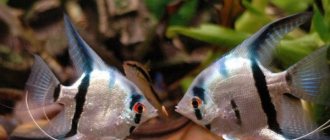Freshwater snails are an important part of the aquarium ecosystem; keeping them at home does not require much effort. The reproduction of most heterosexual and unisexual species of mollusks is unusually fast; in a short time, young individuals fill the aquarium space. Aquarists should know how snails reproduce in order to promptly remove excess young and prevent overpopulation.
The structure of snails
A snail is a mollusk that walks on one leg. On top he wears a shell. Snails have a pair of tentacles on their heads and are able to breathe both in and out of water. They have gills and lungs.
The structure of the snail. Internal and external organs.
You can find both different-sex and same-sex individuals. Some species give birth to live offspring. These include melania. Others lay eggs.
Same-sex individuals have male and female reproductive organs. Often they enter the aquarium already fertilized.
You should not populate the aquarium with snails that were taken from natural bodies of water. They can become a source of infections. You should only buy shellfish from pet stores and from reliable suppliers.
Snails are not picky about their diet; they can even eat leftover food after fish. Thanks to this, the water in the aquarium is well cleaned. Their disadvantages include aquarists: partial or complete destruction of algae and rapid reproduction. Some species also secrete mucus, which makes the water cloudy.
At one time, some types of snails can lay up to 500 eggs. From them emerge rapidly growing cubs. The owner decides what to do with them afterwards.
Features of some snails
The largest species of snails include ampullaria. Its shell can reach 7 cm in diameter, and its leg up to 9 cm. The peculiarity of its structure is that it has a lid at the opening of the shells. Sensing danger, the snail hides, covering it behind itself. She also has a well-developed sense of smell, so when she smells food, she quickly goes to it. This is a heterosexual mollusk. For breeding, 3-4 individuals are enough. Since it lays its eggs above the surface of the water, 2-4 cm of air space should be left in the aquarium.
Physes are small in size. The diameter of their shell does not exceed 2 cm. Their peculiarity is that they secrete a thread that connects the bottom to the surface of the water. This is where snails move.
Viviparous mollusks include melania. They like to hide in the soil, not allowing it to stagnate. They feed on what they can find at the bottom. Melanias reproduce in small quantities. About 50 cubs can be born at one time.
How do Achatina reproduce?
African Achatina are large land mollusks, with high-quality care and maintenance, reaching up to 30 cm in diameter, weighing up to 500 g. Sexual maturity occurs at one year of age. Egg laying occurs every 2 months.
Achatina is a unisexual species, although its representatives are not prone to self-fertilization. More often, individuals fertilize each other. Moreover, they do not have female and male reproductive organs; instead, calcareous formations come out of the front part of the body. The function of the female, that is, the carrier of eggs, is taken over by a larger individual whose body is stronger. Sperm in the Achatina body is stored in a viable state for up to 2 years.
How do snails reproduce in an aquarium?
- Pregnancy lasts 2 weeks.
- Then the pregnant female lays about 200 eggs for further 2-3 weeks of gestation.
- Eggs have a hard shell. As the embryos develop, it becomes thinner and releases minerals to the developing shell.
- When the shell becomes very thin, the snail breaks it and is released.
Feeding of young animals is the same as for adult mollusks. But the food needs to be crushed.
Reproduction process
Reproduction in snails is an almost continuous process. Those who have been breeding them have noticed that in a short period of time, the aquarium is simply filled with mollusks. In order not to reach a critical indicator, this process must be controlled.
To make snails comfortable, they need an aquarium of more than 30 liters. The water must be settled. At first, no more than 4 individuals are introduced into the aquarium. They should be fed once every 1-2 days. The following is used as feed:
- boiled vegetables;
- fish food;
- a small amount of bread.
Aquarium inhabitants feast on melon.
Snails come into the aquarium from pet stores, as well as with purchased plants and stones. They have caviar on them, which is hard to notice. Thus, settlement can occur without the knowledge of the aquarist. Therefore, it is recommended to pre-treat all decorative elements with special solutions. Coils and physes multiply at high speed. With their secretions they can ruin the habitat for fish.
You should not overfeed your fish. The excess food will be eaten by baby mollusks, which will further accelerate their reproduction.
Creating conditions for snail breeding
Reproduction at home among mollusks occurs almost continuously. Without control of the situation, in a short period of time, young individuals literally flood the aquarium space.
How to create comfortable conditions for snail breeding in an aquarium:
- for 4 individuals, take a tank with a volume of 30 liters or more;
- control the water temperature within 25-28°C;
- hardness and acidity do not matter, leave these water parameters the same as usual;
- give food in sufficient quantities once a day or two;
- feed with regular food with the addition of boiled vegetables and bread;
- enrich the diet with calcium;
- change the water weekly without adding water to the edge of the aquarium;
- remove uneaten food from snails.
Eggs are laid on the leaves of underwater plants, tank walls, and decorative elements.
Reproduction methods
In the case of breeding mollusks of different sexes, a female and a male are placed in a separate aquarium. This will ensure their mating. Heterogeneous species of mollusks include:
- tiger snails;
- pagodas: ordinary and brotia;
- neritines: red dot and freshwater;
- Maryse.
After visiting a separate aquarium, they need to be fed generously and the water temperature slightly increased.
Same-sex species include:
- coils;
- tuberous melonoides;
- tropical pond snails;
- Phys.
They have no gender differences. In an aquarium, the role of the male is played by a larger mollusk, and the female is correspondingly smaller.
You should not use individuals from the same litter for the purpose of breeding offspring. Most likely, their cubs will not survive or will have pathologies.
The outer shell of their caviar is quite dense, so fish cannot eat it.
Laying eggs
There are snails that do not need a mate; they are same-sex. Even if there is only one individual in the aquarium, after a while it will give birth to offspring. Snail eggs are laid on algae leaves, aquarium walls, pebbles and decorative items. The masonry cannot be moved to another place. This will lead to the death of the offspring.
Ampullaria snails lay their eggs slightly above the water level. At first, the masonry resembles transparent jelly. After a short period of time it darkens and acquires a brown tint. The color indicates that babies are coming soon.
The ampularia eggs have hatched and you can already see the tiny snails.
Some types of snails bury themselves in the sand and remain there until the eggs hatch. Up to a hundred babies can hatch into the world.
Maryses are heterosexual. Males have a light leg with brown spots, while the female has a darker leg. They can mate for up to 10 hours; the eggs are attached to plants. The clutch appears every 4 days. The birth of mollusks occurs after a week.
It's hard to build a pagoda. This is a viviparous snail. She bears offspring for a month and gives birth to them once a year. Young animals have a high mortality rate.
Snail pagoda. Beautiful, but difficult to reproduce in captivity.
Tilomelania needs a separate reservoir for reproduction. She only bears a couple of eggs at a time.
How do ampullaria reproduce?
Popular Amazonian snails with a yellow or brown-yellow shell reach a diameter of 10 cm. Ampularia is a heterosexual species.
It is impossible to determine the gender; the female does not differ from the male in appearance. Therefore, aquarists buy 4-6 individuals for breeding. You can understand which gender is which by seeing how ampullaria reproduce in an aquarium: the male is always on top during the mating process.
Sexual maturity occurs at 1.5 years. How do yellow snails reproduce in an aquarium:
- After fertilization, eggs are formed in the female's body.
- She deposits them above the water in the form of a slimy mass that hardens in the air.
- In nature, masonry rests on coastal stones and plants. In ampullaria, reproduction in an aquarium occurs on a glass aquarium wall.
- At first, the eggs are translucent, white, with a soft shell, and are 2 mm in diameter. They gradually darken - shells form inside. Just before the young hatch, the eggs are dark brown and hard.
- The developed snails gnaw through the shell of the eggs and come out.
It is necessary to monitor how the snails lay eggs in the aquarium: the clutch should not be allowed to get into the water or get wet, otherwise the embryos will die. How to care for ampularia eggs: drying out of the masonry is unacceptable; if it is laid near a lighting fixture, it will have to be carefully cut off and moved to another place inaccessible to fish and predatory snails. To make it easier to care for caviar, you can place it on a piece of foam plastic placed on the surface of the water.
How quickly snail eggs mature in an aquarium depends on the temperature of the surrounding water. At a temperature of 24-26°C, the ripening period is 2 weeks. At 20°C, young animals appear after 3 weeks.
Caring for young animals is simple: feed – duckweed, finely chopped lettuce leaves, dry planktonic crustaceans. When bred in a community aquarium, young specimens can be eaten by fish, so it is better to move them to a separate tank.
How to stimulate spawning
The snail breeding process must be approached responsibly. They need strict adherence to water temperature. It can range from 25° to 28°. Sudden changes in temperature should not be allowed.
You need to line the bottom of the aquarium with coconut bedding. Sometimes during gestation the snail's shell may burst. To prevent this from happening, a little calcium is added to her diet daily. If all conditions are met, mollusks reproduce every 3-5 days.
How pregnancy affects snail health
Most often, in the natural habitat, pregnancy in Achatina occurs without complications, but in home conditions, unforeseen difficulties are possible.
- Pregnancy inhibits the growth and development of mollusks
- The formation of egg clutch consumes calcium and protein reserves;
- The snail shell becomes thinner, exfoliates and becomes deformed;
- It hibernates if the snail is young and small in size.
Before you start breeding Achatina snails, you must clearly understand that several hundred snails hatch from one clutch, which require a large terrarium, proper care and nutrition. Read about keeping small Achatina. African snails grow quickly and are not so easy to sell or house, and the more snails, the higher the costs. Therefore, breeding snails in order to admire the babies is stupid and imprudent.
What to do with excess shellfish
To reduce the population of aquarium shellfish, you must:
- Use a special chemical. It can be purchased at a pet store. The product, according to the instructions, is poured into the aquarium and after a while the weak snails die. Only in this case you need to be careful, since other inhabitants of the aquarium may die along with the snails: any shrimp and some fish.
- Use electric current. This manipulation is performed by experienced delivery drivers; beginners may not be able to cope with the task.
- You can have Helena. It is known for eating other shellfish. She prefers to live in the sand and reproduces slowly.
The Helena snail is a snail-eating predator.
- Clean with your hands. While cleaning the aquarium, you can remove clutches of eggs or catch adult individuals. To speed up the fishing process, place a cabbage leaf scalded with boiling water on the bottom of the aquarium. Snails gather on it, which are then removed from the aquarium, along with the bait.
- Or you can get snails that do not breed in fresh water.
The coil population is easy to control. Their caviar is dense, so the fish does not touch it, but likes to feed on young animals. Ancistrus catfish feed on young physes. They also eat physid eggs.
Since some types of mollusks reproduce quite quickly. The excess of their clutch can be collected, frozen, and then fed to fish and snails.
The process of birth and formation
The rate at which snails are born depends on environmental parameters. The first fry can hatch in 2 weeks, or maybe in a month. If birth does not occur, the clutch can be divided in half. If no offspring are visible, then fertilization did not occur, or the snails did not develop due to lack of moisture. The young usually do not leave the dry shell and die.
The bulk of newborns die in the first weeks of life, but those who survive gain strength and weight at a rapid pace. During the first six months, the fry reach 3 cm in length; some types of snails can already reproduce.
Young snails eat the same food as their parents.
The only danger is predatory snails or fish that are not averse to snacking on shellfish.
Snail spawns
